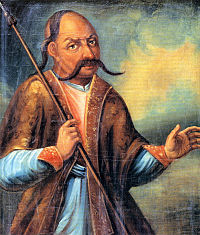- Maksym Zalizniak
-
Maksym Zalizniak (Ukrainian: Максим Залізняк, Maksym Zaliznyak) (born early 1740s in Medvedivka near Chyhyryn - date and place of death unknown, after 1768) - Zaporizhian Cossack, leader of the Koliivshchyna rebellion.
History
Zalizniak was born in a poor peasant family. At a very young age he joined Zaporozhian Host as a mercenary.
By 1767 he had retired from Sich and became a lay brother at Motronynsky Monastery near Chyhyryn. In March he was visited by Joseph Shelest who had a letter from the Zaporozhian Kosh otaman which called all the cossacks to fight against Poland. Witnessing Polish oppression of Ukrainian peasants in right-bank Ukraine Zalizniak left the monastery and led an uprising of over 1,000 cossacks.
He called himself a colonel of Zaporozhian Sich although the people often called him an Otaman.
The main reasons for the uprising were the brutal enforcement of new religious and social-economic laws implemented by the Polish nobility (szlachta) which was very negative regarding Orthodox Christianity.
There was a report of a "Golden document" issued by the Russian Empress Catherine II in support of armed insurrection against non-believers, which included Roman Catholic Poles, Jews and Ukrainians who had become Uniates. The call to armed insurrection was also echoed by father Melkhysedek Zacko-Yavorsky the igumen of the Motrynsky Monastery where Zalizniak had become a dutiful novice.
Hundreds of people responded to Zalizniak’s call. In April 1768 Zalizniak emerged out of Motroninsky Forest and started to advance toward Uman.
Uman and Lysianka became the places of the most violent conflict during Koliivshchyna. At Uman Zalizniak joined forces with Ivan Gonta, who was initially ordered to attack Zalizniak. After Uman fell (see Massacre of Uman), Zaliznyak declared the reinstatement of Hetman State and himself the new Hetman. The Koliivshchyna movement overwhelmed the Poles, and they appealed to Russia for help. Fearing that the rebellion would set a spark off in left-bank Ukraine, Catherine crushed the rebels (known as "haydamaky" – see Haidamaka). Zalizniak and Gonta were captured by Russian colonel Guriev.
As a subject of Russian Empire, Zalizniak was kept under arrest by the Russians, unlike Ivan Gonta, who was turned over to the Poles for execution. On July 8, 1768 Zalizniak and 73 rebels were imprisoned in Kyiv-Pechersk Fortress. At the end of the month the case was ordered to trial by Kyiv Provincial Court. The exact verdict of this trial is unknown, but in view of the fact that Zalizniak operated outside Russian borders he and his cohorts were spared the death sentence (unlike Pugachev, for example). It is believed that the captives were sentenced to exile to Far East or Siberia. Zalizniak was punished by severe whipping and was branded. By November 1, 1768 Zalizniak was deported to Bilhorod. In the vicinity Ohtyrka he and 51 comrades were able to escape by disarming the guards. Most of the fugitives however, including Zalizniak, were quickly captured. His further whereabouts are unknown.
Legacy
In the memory Maksym Zalizniak of the Ukraiian people Zalizniak lives on as a folk hero for the struggle for Ukrainian identity and Christian Orthodox faith. His idealized image is a subject of numerous folk songs, legends and lore.
Sources
- Great Soviet Encyclopedia,
- Russian Wikipedia
Categories:- Cossacks
- Cossack rebels
- Ukrainian Cossacks
- 18th-century Ukrainian people
Wikimedia Foundation. 2010.

